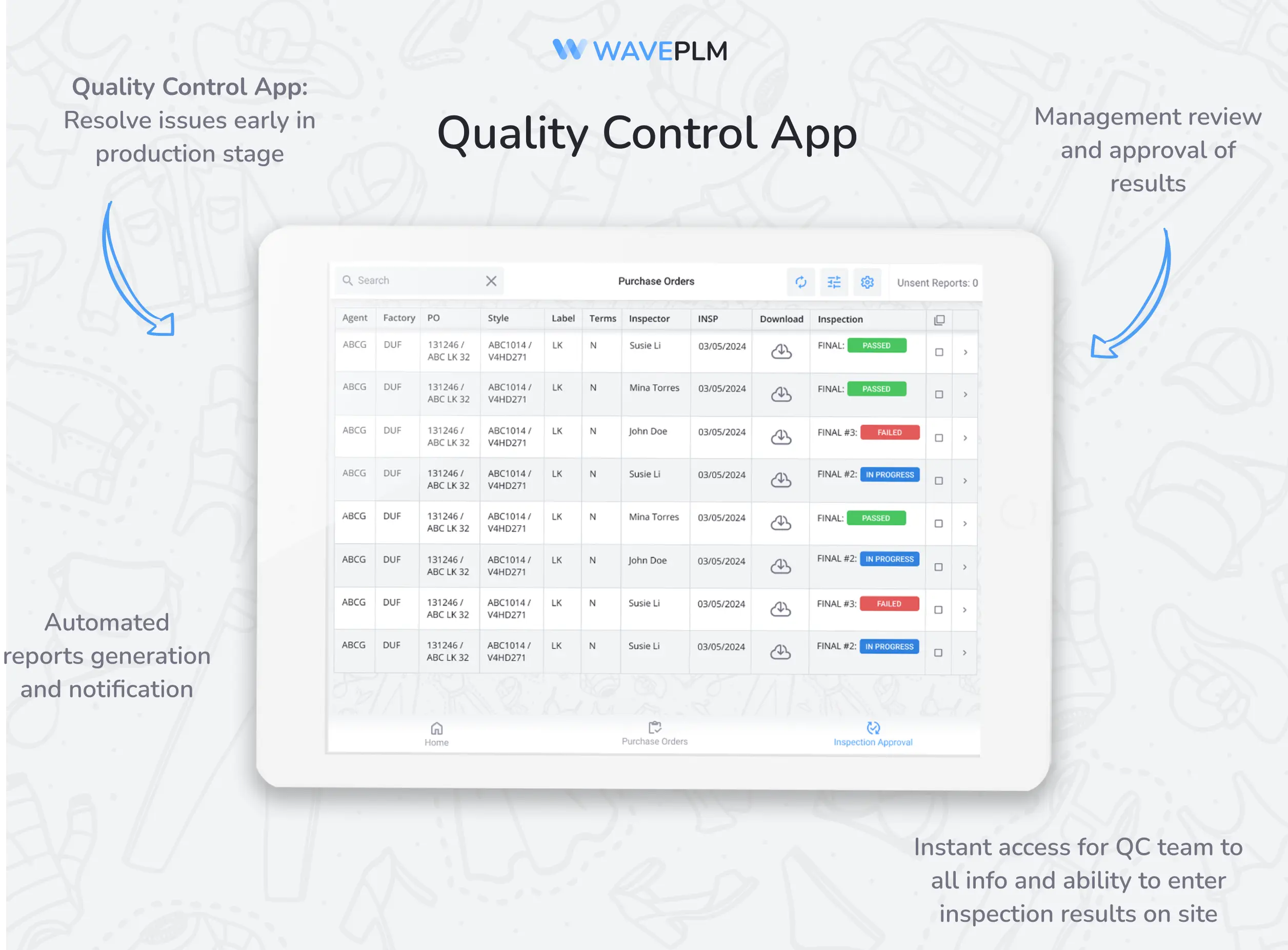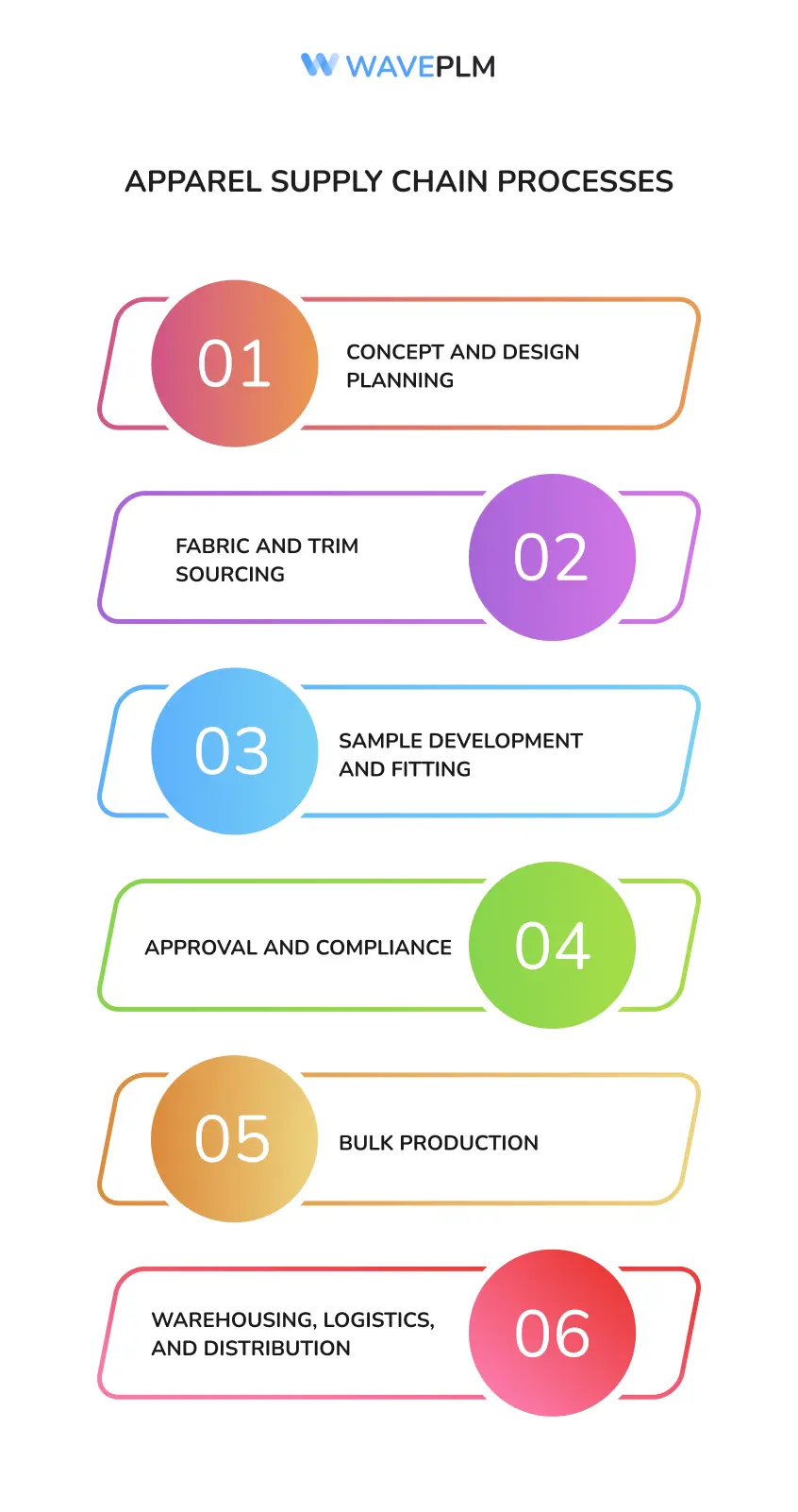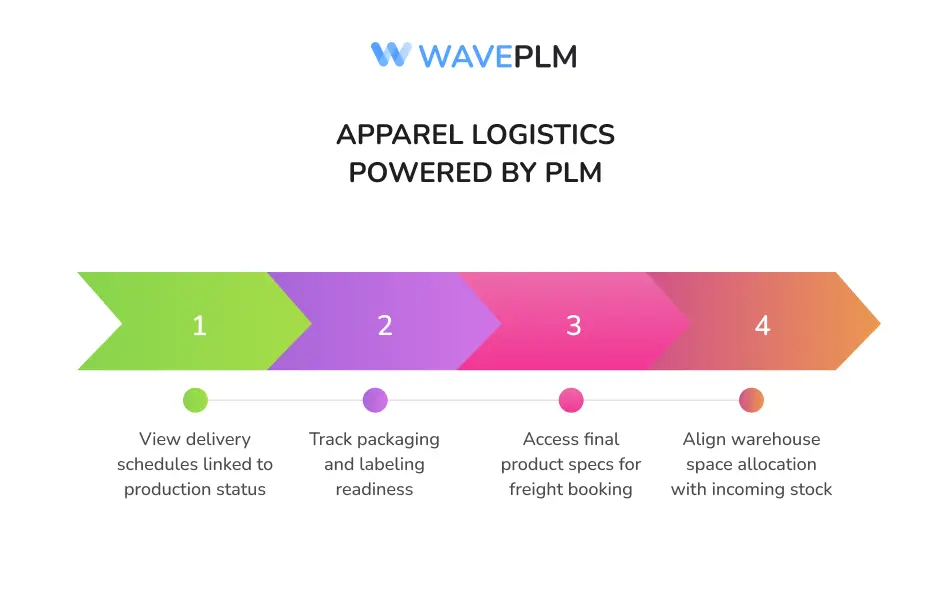
Managing an apparel warehouse requires more than shelves and scanners. It demands precision, coordination, and real-time visibility across the entire apparel supply chain. That’s where PLM software steps in and plays a vital role.
This article takes a closer look at how PLM software creates a unified workflow that connects design, development, production, logistics, and delivery—ensuring every step is aligned long before products arrive at the warehouse apparel stage.
What Is a Warehouse Apparel?
A clothing warehouse, also known as an apparel warehouse, is a specialized storage and distribution center for finished fashion goods. These facilities are responsible for sorting, labeling, storing, and shipping garments like t shirts, hoodies, fleece, and accessories to various sales channels, including retail stores, eCommerce platforms, and third-party resellers.
|
Key Functions of an Apparel Warehouse |
|---|
|
Inventory Storage |
|
Order Picking and Packing |
|
Returns Processing |
|
Stock Replenishment |
|
Distribution and Shipping |
|
Quality Checks and Repackaging |
|
Barcode Scanning and Labeling |
Warehouse success depends not only on physical organization but also on the accuracy of the data feeding into it. Errors in product details, labels, or codes can disrupt workflows and lead to costly delays.
Introduction to Apparel Warehouses
Apparel warehouses are facilities that store and manage a wide variety of clothing and accessories, including t-shirts, hoodies, and fleece. These warehouses are often the backbone of a business, providing a centralized location for inventory management and order fulfillment. By subscribing to a warehouse’s marketing communications, customers can stay up-to-date on new products and promotions, and even receive exclusive offers. Founded on the principles of quality and dedication, apparel warehouses strive to provide a quick and efficient shopping experience, whether it’s through a quick shop or a more leisurely browse of the category pages. With a focus on customer satisfaction, apparel warehouses aim to make every day a great day to shop.
Warehouse Operations
Warehouse operations are the behind-the-scenes activities that keep an apparel warehouse running smoothly. This includes managing inventory, processing orders, and ensuring that all products are properly stored and handled. A key aspect of warehouse operations is maintaining a clean and organized facility, with a focus on safety and security. By agreeing to receive marketing communications, customers can help support the warehouse’s business operations and stay informed about new products and promotions. From blue jeans to orange hoodies, warehouse operations are designed to get products to customers quickly and efficiently, whether they’re shopping online or in-person.
Inventory Management and Quality Control
Inventory management and quality control are critical components of a successful apparel warehouse. This involves carefully tracking and managing stock levels, as well as inspecting products for quality and accuracy. By using a variety of tools and techniques, including category management and cart tracking, warehouses can ensure that products are properly stored and handled, and that customers receive the best possible products. Whether it’s a small batch of t-shirts or a large shipment of fleece, inventory management and quality control are essential for maintaining a high level of customer satisfaction. By looking for warehouses that prioritize quality control, customers can trust that they’re getting the best products available.

Order Fulfillment and Shipping
Order fulfillment and shipping are the final steps in the warehouse process, and are critical for getting products to customers quickly and efficiently. This involves carefully packaging and labeling orders, as well as selecting the best shipping options to ensure timely delivery. By using a variety of shipping methods, including ground, air, and express, warehouses can get products to customers all over the world, whether they’re shopping online or in-person. From the cart to the customer’s doorstep, order fulfillment and shipping are essential for providing a great customer experience. By subscribing to a warehouse’s marketing communications, customers can stay up-to-date on shipping options and estimated delivery times.
Security and Safety
Security and safety are top priorities for apparel warehouses, which often store large quantities of valuable merchandise. This includes implementing robust security measures, such as cameras and alarms, as well as ensuring that all employees are properly trained and equipped to handle products safely. By agreeing to receive marketing communications, customers can help support the warehouse’s security and safety efforts, and stay informed about any updates or changes to the facility. Whether it’s a small warehouse or a large distribution center, security and safety are essential for protecting products and employees, and for maintaining a high level of customer trust.
Sustainability and Environmental Responsibility
Sustainability and environmental responsibility are increasingly important considerations for apparel warehouses, which often have a significant impact on the environment. This includes implementing eco-friendly practices, such as recycling and energy-efficient lighting, as well as sourcing products from suppliers who share these values. By looking for warehouses that prioritize sustainability, customers can trust that they’re supporting a business that cares about the environment. From reducing waste to using environmentally-friendly packaging materials, apparel warehouses can make a positive impact on the planet, while also providing great products and services to customers. By subscribing to a warehouse’s marketing communications, customers can stay up-to-date on the latest sustainability initiatives and efforts.
The Apparel Supply Chain: More Than Warehousing
The apparel supply chain consists of a complex set of processes, all of which must operate smoothly to ensure on-time delivery:
- Concept and design planning
- Fabric and trim sourcing
- Sample development and fitting
- Approval and compliance
- Bulk production
- Warehousing, logistics, and distribution
If any step is out of sync, delays cascade downstream. PLM software creates a connected environment where product information—from the first sketch to final delivery—is always current and accessible. This integration allows warehouse teams to receive accurate data and fulfill shipments without friction.

What Is PLM Software?
PLM software (Product Lifecycle Management) is a digital platform used to manage the entire lifecycle of a product. It links internal teams such as designers, developers, merchandisers, and logistics coordinators with external suppliers and manufacturers. This end-to-end visibility helps organizations avoid miscommunication and maintain consistency. For example, PLM software helps manage t-shirt data, ensuring consistency in styles, colors, and sizes, and avoiding miscommunication between teams.
|
PLM Software Features |
|---|
|
Centralized Product Data |
|
BOM (Bill of Materials) Management |
|
Tech Pack Creation and Sharing |
|
Sample Feedback and Tracking |
|
Colorways, Sizes, and Grading Rules |
|
Task Assignments and Status Updates |
|
Apparel Inventory Integration |
With PLM like Wave PLM, every stakeholder in the apparel business—no matter their location—can collaborate on the same platform in real time.
Why Warehouse Operations Need PLM
Warehouse issues often originate in earlier production stages. When details like colorways, fabric weights, or size specs change but aren’t communicated, the warehouse receives the wrong goods or incomplete documentation. This results in returns, repacking, or failed delivery attempts.
PLM prevents such issues by:
- Ensuring updated design specs are shared instantly
- Automating handovers from production to warehousing
- Connecting sample approvals with final production specs
- Providing transparency into order timelines and changes
These capabilities support warehouse teams in preparing space, labor, and packaging based on accurate expectations.
PLM and Warehouse Optimization
Warehouse optimization refers to making warehouse operations faster, more accurate, and less expensive. This includes minimizing storage times, improving inventory accuracy, and reducing unnecessary handling.
PLM software contributes by:
- Reducing manual entry through automated data sync
- Linking final product SKUs to approved BOMs
- Enabling pre-pack planning by sharing size and ratio breakdowns
- Allowing suppliers to upload shipping docs directly into the system
|
PLM Advantages for Apparel Warehousing |
|
Accurate Style/Size Mapping |
|
Reduced Shipping Errors |
|
Streamlined Product Identification |
|
Improved Apparel Inventory Tracking |
|
Fewer Returns and Reorders |
|
Enhanced Data Sharing with 3PLs |
This creates a smart warehouse ecosystem that reacts in real time, rather than one dependent on manual follow-up and corrections.
Real-Life Warehouse Apparel Challenges
Let’s explore common warehouse apparel challenges—and how PLM helps solve them:
Without PLM:
- T shirts shipped in the wrong colors (e.g., orange instead of blue)
- Missing labels for new accessories
- Items not categorized correctly, causing confusion in sorting
- Unavailable fleece sizes, despite appearing in stock
With PLM:
- Color and size data are synced to WMS (Warehouse Management System)
- Marketing communications are updated with verified product information
- PLM alerts teams to spec changes before shipment
- Barcodes and tags match tech pack specifications
As a result, warehouse processes become more predictable, consistent, and less labor-intensive.
From Sample to Cart: A Streamlined Flow
PLM powers every step of the apparel development journey, including the critical transition from product completion to shopper-facing availability. This includes preparing for quick shop features, product listings, and eCommerce cart readiness.
|
Stage |
PLM Contribution |
|
Design |
Stores BOMs, size ranges, fabric details |
|
Development |
Manages fitting rounds and changes |
|
Production |
Shares color approvals and readiness |
|
Warehouse |
Aligns packaging and shipment expectations |
|
Quick Shop |
Ensures SKUs match front-end product data |
|
Marketing |
Syncs visuals and categories with inventory |
By ensuring each team has real-time access to product status, PLM helps reduce duplication, accelerate turnaround times, and eliminate information silos.
Inventory and Cart Accuracy with PLM
Every product listing, cart item, and checkout experience depends on inventory accuracy. Overstocking leads to markdowns, while stockouts result in lost sales and poor customer reviews.
PLM addresses this by:
- Sharing real-time production and delivery forecasts
- Helping brands launch products in smaller, more controlled batches
- Identifying sales patterns and linking them to design adjustments
- Supporting smart replenishment through shared demand data
Shoppers benefit from confidence in availability, while operations teams can better plan for the day-to-day volume in the warehouse.
Apparel Logistics Powered by PLM
PLM plays a vital role in apparel logistics by coordinating supply chain touchpoints. Logistics teams can:
- View delivery schedules linked to production status
- Track packaging and labeling readiness
- Access final product specs for freight booking
- Align warehouse space allocation with incoming stock
|
Logistics Gains from PLM |
|
Faster Turnaround Times |
|
Optimized Packaging Plans |
|
Fewer Delivery Errors |
|
Aligned Inventory Drops |
|
Transparent Documentation |
By integrating these capabilities, brands reduce costly warehousing inefficiencies and elevate customer satisfaction.

FAQ Section
What is a clothing warehouse? It’s a dedicated facility where garments like t shirts, fleece, and accessories are stored and processed before final delivery.
What is an apparel wholesaler? An apparel wholesaler is a business that purchases bulk goods from manufacturers and resells them to shops and other vendors.
What happened to the Warehouse clothing brand? Warehouse was a popular UK-based brand that closed in 2020. Its legacy still resonates in nostalgic marketing communications and retail culture.
Who is the largest apparel retailer? As of today, Inditex (Zara) leads globally, with Uniqlo and H&M also holding major market shares.
Summary: Improve Apparel Warehouse Operations with PLM
Apparel warehousing is more than storage—it’s a critical point of connection between production and the customer. When every product detail is managed accurately, every box shipped supports the brand promise.
Top Benefits of PLM for Warehouse Optimization:
- End-to-end visibility from concept to customer
- Real-time apparel inventory and SKU sync
- Enhanced collaboration across teams
- Increased accuracy for quick shop, cart, and delivery modules
Take the next step: Subscribe to receive marketing communications, updates, and insights on how to transform your fashion operations.
Wave PLM was founded to simplify complexity, streamline warehouse apparel workflows, and empower businesses to scale with confidence across every category of wear.




